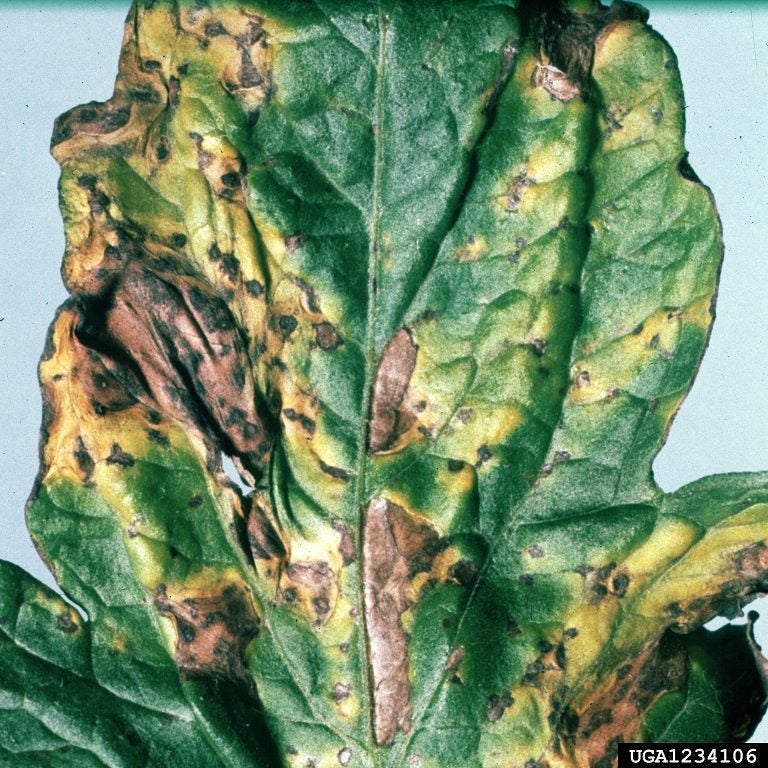Tomato Gray Leaf Spot Control: Managing Gray Leaf Spot On Tomatoes


Sweet, juicy, ripe tomatoes from the garden are a treat worth waiting for until summer. Unfortunately, that lusted for crop can be brought down low by numerous diseases and pests. Gray leaf spot on tomatoes is a classic example and is one of the many diseases that can strike plants in the nightshade family. Tomato gray leaf spot control is actually quite simple provided you practice good cultivation and hygienic routines.
What is Tomato Gray Leaf Spot?
You head out to inspect your bountiful tomato plants only to discover brown to gray lesions with a yellow halo. This is a common fungal disease that affects plants at any stage of their life. This is a fungal disease and doesn't affect those marvelous fruits, but it can diminish the health of the plant and, therefore, the quality of fruit production. Gray leaf spot on tomatoes is caused by the fungus Stemphylium solani. It causes the lesions on leaves which become glazed in the center and crack. This produces shot holes as the disease progresses. Lesions grow up to 1/8 (.31cm.) across. The affected leaves die and drop. Stems may also develop spots, primarily young stems and petioles. The consistently dropped leaves can lead to sunscald on fruit, which can make the tomato unpalatable. Tomatoes grown in the southern states are primarily affected. The disease favors moist, warm conditions, especially when moisture on leaves has no time to dry before evening dew arrives.
Causes of Gray Leaf Spot of Tomatoes
Treating gray leaf spot on tomatoes isn't as important as making sure the plants never get the disease in the first place. Prevention is always easier, so it is necessary to understand where this disease hides. In the garden, it will overwinter in plant debris. Not only tomatoes but other nightshade leaves and stems that have fallen can harbor the disease. In heavy spring rains and wind, the disease spreads through rain splash and wind. Good hygienic measures go a long way to preventing the disease. Sanitation of tools and equipment can also prevent this fungus from moving into other unaffected beds.
Tomato Gray Leaf Spot Control
Some growers recommend treating gray leaf spot on tomatoes by using an early season fungicide. This can help prevent a variety of fungal diseases. There are also a few resistant tomato varieties if you can find them in your region. The best tomato gray leaf spot control is crop rotation followed with seedbed sanitation and fungicide applications early in plant development. You can also hand pick off affected leaves to prevent the rapid spread of the fungus on the plant. Destroy any plant material rather than placing it in the compost pile.
Gardening tips, videos, info and more delivered right to your inbox!
Sign up for the Gardening Know How newsletter today and receive a free copy of our e-book "How to Grow Delicious Tomatoes".

Bonnie Grant is a professional landscaper with a Certification in Urban Gardening. She has been gardening and writing for 15 years. A former professional chef, she has a passion for edible landscaping.
-
 Create A Romantic Garden Straight Out Of Bridgerton: Regency Era Romance In Your Garden
Create A Romantic Garden Straight Out Of Bridgerton: Regency Era Romance In Your GardenTry some romantic garden ideas straight out of Bridgerton. Flowers and gardens in the Regency era were lush and charming and you can get the same look!
By Bonnie L. Grant
-
 Moody Blooms For Spring: 8 Types Of Black Flowers To Add Drama To Spring Displays
Moody Blooms For Spring: 8 Types Of Black Flowers To Add Drama To Spring DisplaysFrom midnight burgundies to inky violets, several types of black flowers can enrich and embolden a spring display. Try these brooding bloomers for a moody garden
By Tonya Barnett